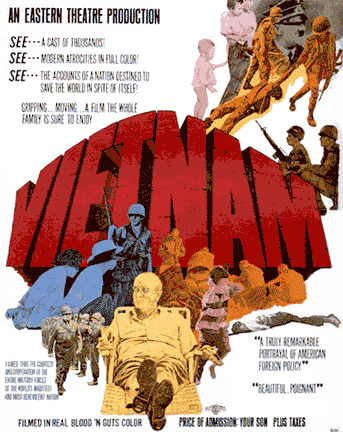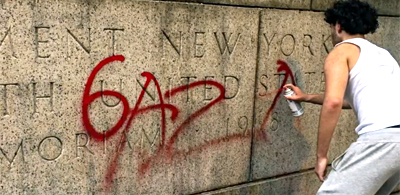LBJ, Obama & Afghanistan
On December 1, 2009, in an address to the nation delivered from the United States Military Academy at West Point, President Obama announced the sending of an additional 30,000 U.S. combat troops to Afghanistan in order to wage what he calls a “war of necessity.”

To mark the occasion I have written, “Hey, Hey, LBJ…”, an illustrated essay on the subject of U.S. protest posters from the 1960s that lambasted that other liberal Democratic President who supposedly possessed a progressive domestic social agenda – Lyndon Baines Johnson, or L.B.J. (1963-1969).
L.B.J.’s assumed intentions of wanting to implement wide-ranging social reforms in the U.S. were thwarted by his ever increasing military escalation of an unpopular war in Vietnam. President Obama has similarly opened a Pandora’s box with his sharp military escalation in Afghanistan; and while the “Hey, Hey, LBJ…” presentation examines 15 historic posters from our collective past, it also offers the reader glimpses of what the future could possibly hold for us all.
The 15 posters I have written about in my essay disparaged L.B.J.’s foreign and domestic policies with wry humor, sardonic wit, and pointed outrage. What’s more, the prints were exceptional from a design standpoint, and they continue to stand as important political and cultural documents in American history. Despite their historic value and obvious political and aesthetic significance, few of the posters I present in my essay are to be found in online collections, even though they were widely distributed and known in the 1960s. Most of the posters featured in my essay have not been seen since they were first published.
With his December 1 troop deployment announcement, President Obama has fully completed his metamorphosis into L.B.J. Less than one year after his inauguration, Mr. Obama’s promises of delivering “Hope” and “Change” have ended up being battlefield fatalities on the arid plains of Afghanistan. Rather than delivering his diktat of escalating war from the Oval Office of the White House, Mr. Obama revealed his war plans at the same service academy used in 2002 by George W. Bush when the former president explained his Orwellian “Preventative War” doctrine. West Point afforded Mr. Obama the opportunity of presenting his military strategy for Afghanistan against a backdrop of soldiers and Academy cadets – a setting conveying resolute leadership from the nation’s Commander in Chief. How ironic that Obama will next travel to Oslo, Norway to accept the Nobel Peace Prize on December 10.
Obama administration officials have calculated that the Afghan war will cost $1 trillion over the next 10 years – a figure most likely underestimated. The Pentagon says that annually it spends $1 billion for every 1,000 soldiers in Afghanistan; and that by the time it delivers a single gallon of fuel to the landlocked country for use by U.S. soldiers, the cost has skyrocketed to $400 per gallon. As the U.S. economy teeters, the Bureau of Labor Statistics reported that the unemployment rate reached 10.2 percent in November ’09 – that’s 15.7 million Americans without work; the New York Times noted, “If the unemployed lived in one state, it would be the country’s fifth largest.” Just prior to his West Point troop deployment announcement, President Obama boasted that he would “finish the job” in Afghanistan; if the “job” in question is to drive the U.S. further into economic collapse, then Mr. Obama may well achieve his goal.
To help finance the unpopular war in Vietnam, L.B.J. imposed a 10-percent surtax on the American people. Not to be outdone, a number of powerful Congressional Democrats are today hoping to pass the “Share the Sacrifice Act”, a surtax to be forced upon all U.S. citizens in order to help pay for Obama’s war in Afghanistan. The bill would place a 1-percent surtax on all those who earn less than $150,000, with up to 5-percent imposed on those with higher incomes.
The particulars of Obama’s odious decisions should not hinder our optimism and authentic struggle for the democratization and transformation of society. Such a project should never be reliant upon a single politician or individual – the people in motion are the true engine of history. The publication of “Hey, Hey, LBJ…” is but a small contribution towards wiping away debilitating historical amnesia and political illusions, allowing us to thoughtfully plot a course of action for building a society where words like “Hope” and “Change” are not slogans from some clever marketing and branding campaign – but expressions of a mass democratic impulse fully implemented by a free people.
The complete “Hey, Hey, LBJ…” illustrated essay can be viewed at:
www.art-for-a-change.com/LBJ/LBJ.htm




